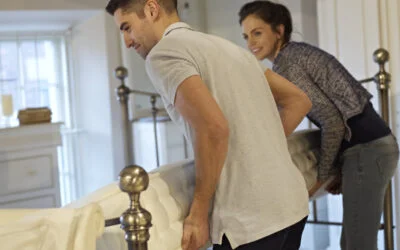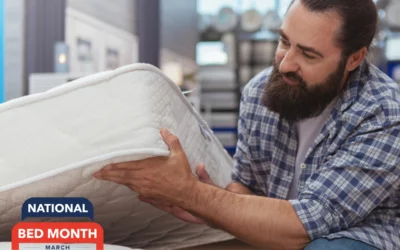Buying a new mattress can be a confusing, frustrating experience. Firstly, it’s not something you do very often – like buying a can of beans or a family holiday. On average, people only buy three of four mattresses for themselves in a lifetime.
You may be a highly qualified, intelligent person but know very little about mattresses – it’s just not a subject that you think about until it’s time you need a new one. Then, when you do, you have to rely on advice from a salesperson in a store or you trawl through online reviews which, as we are now increasingly warned, may well be fake!
So let’s look at some of the myths surrounding buying mattresses.
Turning your mattress over will double its lifespan. In the not too distant past, most mattresses were made double-sided and users were encouraged to regularly turn them over as well as rotate the mattress from head to toe. Regular rotating and turning was necessary to even out the wear and tear and to allow the mattress fillings to settle correctly. This undoubtedly made the mattress perform better and will have extended its useful life but probably not doubling it.
Many of today’s mattresses are designed to only be slept on one side. The latest technological developments in spring manufacturing and mattress fillings means that you no longer need to struggle turning heavy mattresses which arguably result in back injuries in the first place. Our advice is to always follow the manufacturer’s instructions on how to care for your mattress.
A firm mattress is best for a bad back. This used to be common advice given by many GPs as well as telling their patients to “put an old door or planks of wood under your mattress”. The truth is that there are so many reasons for a bad back and many different types of back, shoulder and hip pain. The  most important thing is to choose a mattress that offers correct support for your spine – one that keeps your spine straight when you lie on your side or in its natural curve when you lie on your back. A mattress that is too firm will cause pinching of nerves, reduced blood flow and lead to numbness or pins and needles. Muscles have to work harder to get comfortable, resulting in strain on tendons and leading to pain. If your mattress has seen better days, there’s a good chance that it may be a contributing factor to any back pain. Buying a new mattress that provides the right level of comfort and support may well help or even cure back pain.
most important thing is to choose a mattress that offers correct support for your spine – one that keeps your spine straight when you lie on your side or in its natural curve when you lie on your back. A mattress that is too firm will cause pinching of nerves, reduced blood flow and lead to numbness or pins and needles. Muscles have to work harder to get comfortable, resulting in strain on tendons and leading to pain. If your mattress has seen better days, there’s a good chance that it may be a contributing factor to any back pain. Buying a new mattress that provides the right level of comfort and support may well help or even cure back pain.
The more springs in a mattress, the more comfortable it is and the better its support. There is a degree of truth in this but only up to a point. In the UK, there appears to be an obsession with spring count with some mattresses now boasting spring counts of 10,000 or more for a king size. Using standard size pocket springs in a single layer, a basic king size mattress would contain around 800 and the maximum would be around 2,000.
To achieve any more than this, the manufacturer will need to place one unit of springs on top of another or use layers of mini or micro pocket springs. Some manufacturers use these layers of mini springs as comfort layers instead of using foam, fibre or natural fillings such as wool, cotton, silk, cashmere or mohair. So, a mattress claiming to contain 5,000 pocket springs may only have a basic 800 spring unit providing the core support with the remaining 4,200 springs being micro coils as comfort layers.
The more you pay, the better the mattress and the better you sleep. Again, there is some truth in this but comfort is so subjective that what one person finds ideal, another person may find extremely uncomfortable. There is no guarantee that a £2,000 mattress will make you sleep better than one costing £500. If you find them both comfortable when you try them in a store, you need to find out what you’re getting for the extra money. Does the more expensive one come with a longer guarantee period? Does it contain more natural fillings or higher quality ones than the £500 mattress? Are the finishing touches and overall appearance of a higher standard? Is it made by a well-respected brand with a reputation for quality and customer service excellence?
The base makes little difference to the comfort and longevity of the mattress. Not true. The base plays a vital role in both. Placing a new mattress on an old, worn out base is a bit like buying a new car and putting old tyres on it. It’s just false economy and will adversely affect the performance. Also, different types of base will have a dramatic effect on the feel of your mattress. A sprung base or one with flexible slats offer gentler support to the mattress than a solid platform base or one with rigid slats. If you place your mattress on a solid platform, the mattress works in isolation to support you, taking all the strain on its own. A softer base works in conjunction with your mattress to support you, effectively extending the useful life of the mattress.






0 Comments